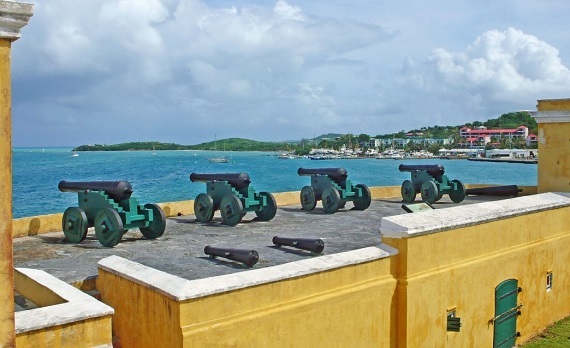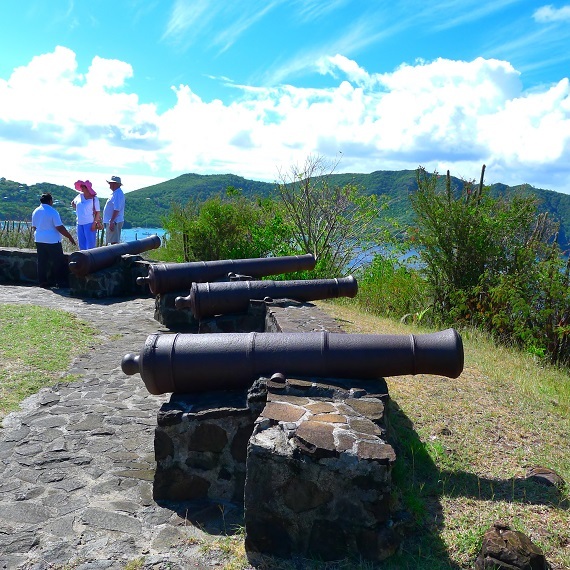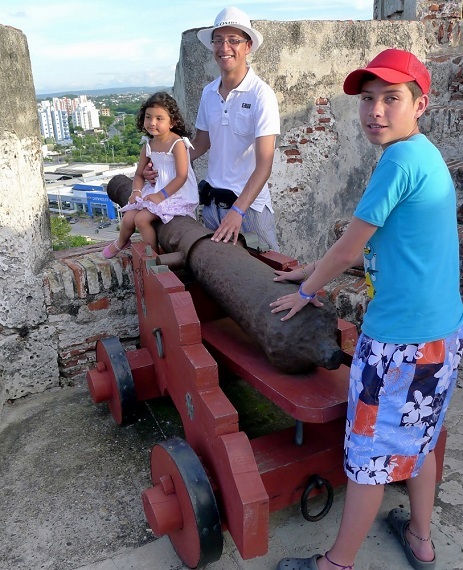Have you ever wondered why there are so many old-time forts on the Caribbean islands? And who built them? And why?
You'll spot forts just about everywhere on the old "Spanish Main" - meaning all the Caribbean islands and the countries rimming them along the coasts of Central and South America. Some are jumbo-size, like the $2 trillion monster fort overlooking the Colombian harbor of Cartagena, where treasure galleons gathered to sail in convoys to Spain. Other forts, like those perched on some of the hilltops in the Grenadines, boast just a cannon or two.

Spanish super-fort guarded treasure fleets at Cartagena, Colombia.
Most of the forts were built during the 17th and 18th centuries when Spain, France, England and The Netherlands were slugging it out to grab islands to grow sugarcane, tobacco, cotton and the like. Not only did all these countries have to keep an eye out for each other's ships, but also for guys with eye patches sailing around under the flag of the Jolly Roger.
At one time hundreds of pirates roamed the Caribbean, hoping to bag slow-moving cargo ships (whether they flew the colors of Spain, England, France or anyone else). When they couldn't find any merchant ships to loot, they settled for plundering lightly defended ports.

Ancient cannons stand silent vigil on St. Croix, U.S. Virgin Islands.
Sometimes the colors of different nations flew over the same forts at different times. For instance, during a long series of wars between France and England, France's Fleur-de-lis went down and England's Union Jack went up on the island of St. Lucia seven times before France finally threw in the towel in 1814.

Photo from Jade Mountain shows volcanic peaks soaring over St. Lucia.
"The War of Jenkins Ear" was another big flag-changer. This one started off the coast of Florida in 1731 when a Spanish ship captured a British merchant vessel commanded by Robert Jenkins. For some reason, the Spanish commander cut off one of Jenkins' ears.
Now, the Brits could hardly take that insult lying down, so - after one thing led to another (including bickering over the rights to sell slaves in the Caribbean) - they ended up declaring war on Spain. In one battle, an English fleet led by Admiral Edward "Old Grog" Vernon captured and sacked the wealthy Spanish port at Portobello, Panama. Flushed with success, Vernon went on to attack another big Spanish port down the coast at Cartagena - and literally ran into a stone wall at the mega-fort there. Vernon showed up with a force of 23,000 men and 186 ships bristling with 2,000 cannons, but the fort, defended by just 3,000 Spanish troops and six ships, sent Old Grog packing after a month-long siege of the city.

Cannons dot the hilltops of St. Vincent and the Grenadines.
And so it went over the years, until the mid-1700s when piracy fizzled out and the forts had a little less to do. But what put them out of business was an all-hands summit of the European powers in 1815, at the end of the Napoleonic wars. Called the Congress of Vienna, the pact divvied up Europe to the likes of the big players in return for everyone's promise to behave.
And as Europe went, so did the Caribbean, with certain islands going to the English, French, Spanish and Dutch. Most of the islands have since gained their independence, semi-independence, or fewer ties to their overseas parent countries.

Family poses on a cannon that once blasted enemy ships.
All those ancient forts, once bristling with cannons manned by sharp-eyed gunners, are now full of tourists scampering around their ramparts and posing for pictures on the cannons.
All photos by Bob Schulman.
Our 2024 Coverage Needs You
It's Another Trump-Biden Showdown — And We Need Your Help
The Future Of Democracy Is At Stake
Our 2024 Coverage Needs You
Your Loyalty Means The World To Us
As Americans head to the polls in 2024, the very future of our country is at stake. At HuffPost, we believe that a free press is critical to creating well-informed voters. That's why our journalism is free for everyone, even though other newsrooms retreat behind expensive paywalls.
Our journalists will continue to cover the twists and turns during this historic presidential election. With your help, we'll bring you hard-hitting investigations, well-researched analysis and timely takes you can't find elsewhere. Reporting in this current political climate is a responsibility we do not take lightly, and we thank you for your support.
Contribute as little as $2 to keep our news free for all.
Can't afford to donate? Support HuffPost by creating a free account and log in while you read.
The 2024 election is heating up, and women's rights, health care, voting rights, and the very future of democracy are all at stake. Donald Trump will face Joe Biden in the most consequential vote of our time. And HuffPost will be there, covering every twist and turn. America's future hangs in the balance. Would you consider contributing to support our journalism and keep it free for all during this critical season?
HuffPost believes news should be accessible to everyone, regardless of their ability to pay for it. We rely on readers like you to help fund our work. Any contribution you can make — even as little as $2 — goes directly toward supporting the impactful journalism that we will continue to produce this year. Thank you for being part of our story.
Can't afford to donate? Support HuffPost by creating a free account and log in while you read.
It's official: Donald Trump will face Joe Biden this fall in the presidential election. As we face the most consequential presidential election of our time, HuffPost is committed to bringing you up-to-date, accurate news about the 2024 race. While other outlets have retreated behind paywalls, you can trust our news will stay free.
But we can't do it without your help. Reader funding is one of the key ways we support our newsroom. Would you consider making a donation to help fund our news during this critical time? Your contributions are vital to supporting a free press.
Contribute as little as $2 to keep our journalism free and accessible to all.
Can't afford to donate? Support HuffPost by creating a free account and log in while you read.
As Americans head to the polls in 2024, the very future of our country is at stake. At HuffPost, we believe that a free press is critical to creating well-informed voters. That's why our journalism is free for everyone, even though other newsrooms retreat behind expensive paywalls.
Our journalists will continue to cover the twists and turns during this historic presidential election. With your help, we'll bring you hard-hitting investigations, well-researched analysis and timely takes you can't find elsewhere. Reporting in this current political climate is a responsibility we do not take lightly, and we thank you for your support.
Contribute as little as $2 to keep our news free for all.
Can't afford to donate? Support HuffPost by creating a free account and log in while you read.
Dear HuffPost Reader
Thank you for your past contribution to HuffPost. We are sincerely grateful for readers like you who help us ensure that we can keep our journalism free for everyone.
The stakes are high this year, and our 2024 coverage could use continued support. Would you consider becoming a regular HuffPost contributor?
Dear HuffPost Reader
Thank you for your past contribution to HuffPost. We are sincerely grateful for readers like you who help us ensure that we can keep our journalism free for everyone.
The stakes are high this year, and our 2024 coverage could use continued support. If circumstances have changed since you last contributed, we hope you'll consider contributing to HuffPost once more.
Already contributed? Log in to hide these messages.




